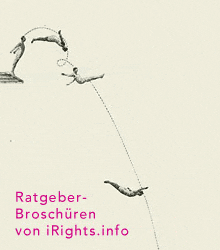Es wird spannnend / dringend: Neues zur Schutzdauerverlängerung für Musikaufnahmen
Martin Kretschmer, den ich kürzlich zu den Plänen der EU-Kommission interviewt habe, die Schutzdauer für Musikaufnahmen auf 95 Jahre zu verlängern (von derzeit 50), hat nun eine Stellungnahme (PDF, 248 KB) dazu verfasst.
Sie antwortet im Detail auf die Behauptungen der Kommission und der Lobbyisten der Musikindustrie.
Zusätzlich hat er einen offenen Brief an die Abgeordneten des EU-Parlaments geschrieben, in dem er erläutert, warum die Unterzeichner die Richtlinie zur Schutzdauerverlängerung als “eins der schlimmsten Beispiele für ein Plädoyer im Eigeninteresse” ansehen: “Die Vorgeschlagene Richtlinie wird europäische Innovation und Kreativität erheblich schädigen.”
Unterzeichnet, neben Kretschmer, von einigen der prominentesten Urheberrechtlern Europas: Professor Lionel Bently and Dr Rufus Pollock, Centre for Intellectual Property & information Law (CIPIL), University of Cambridge; Professor Reto Hilty, Max-Planck-Institut für Geistiges Eigentum, Wettbewerbs- und Steuerrecht, München; Professor Bernt Hugenholtz, Institute for information Law, Universität Amsterdam.
Der gesamte Brief (Englisch):
The Business School
Professor Martin Kretschmer
Director; Centre for Intellectual Property Policy & Management
Bournemouth, 27 October 2008
Open letter to the Members of the European Parliament
The Proposed Directive for a Copyright Term Extension
We are independent lawyers, economists and music researchers, representing the leading European intellectual property research centres. We unanimously condemn the Commission’s proposed directive “amending the term of protection of copyright and certain related rights” (COM(2008) 464/3) as one of the worst examples of special interest pleading. The proposed directive will seriously damage European innovation and creative endeavour.
The Commission is trying to persuade policy makers that copyright extension is cost free. ln its Impact Assessment [IA] the Commission claims that consumer prices for sound recordings will not increase, nor will licence fees paid by broadcasters, clubs and restaurants for so-called “air play” [IA, p. 40].
At the same time the Commission claims that extension will deliver benefits to the music industry between € 44 million and € 843 million” [IA, p. 60]. Where is that money coming from? The costs have to be borne somewhere. It is shocking that the Commission can fail to acknowledge this basic economic truth. Any serious impact assessment should at least have to answer the simple question: Who is going to pay?
Instead of doing their economic homework, the Commission offers a misleading story about performers facing “an income gap at the end of their Iifetimes” [Explanatory Memorandum to Proposed Directive, p. 4; Press releases 14 February 2008 and 16 July 2008]. The language of “artists who lose their pension when they need it most” is copied directly from lobby documents supplied to the Commission by the record industry. Extension is then dressedup as a “sociaI measure”.
The most cursory analysis will show that nothing could be further from the truth. Under the current 50 year term, a track recorded when a performer was 25 will be protected until age 75. lf the artist continued recording throughout her performing life, the current term will most likely outlast the performer’s lifespan. Not a single artist has a life expectancy of 45 years at age 75 – yet this is the extension the Commission proposes. lf the Commission
really wanted to help performers, it would (i) limit the term to the artist’s life, (ii) make such a term not available to record producers (labels), and (iii) look at recording contracts during the existing term. Any independent assessment will show the “ageing performers” argument as a smoke screen.
The chief beneficiaries from extension are:
1. Major rightholders who control a back catalogue of records that reaches back further than 50 years. The four major multinational record companies Universal, Sony BMG, Warner Music and EMI own almost all the key records that would benefit from retrospective extension.
2. Best-selling artists such as Cliff Richard, Johnny Hallyday, and their future estates. Is channelling money to estates a productive measure?
3. Collecting societies who will process increased income either from airplay or a social fund (and take a commission for it).
4. Minor beneficiaries are ordinary working performers. The bottom 80% of performers would each receive between € 4 and € 58 a year (calculation based on Commissions own figures). Some of these benefits however come at the costs of younger performers just entering the profession, as the same pot of money will have to be shared by more artists, many of whom are or will be dead. The contrast between marginal benefits to ordinary performers, and huge benefits to multinational producers is stark. The costs of copyright extension will be borne by European society as a whole through higher prices and licence fees, stymied innovation, and hindered diversity. In order to facilitate informed democratic debate, we have prepared
– specific independent responses to the Commission’s Frequently Asked Questions template
– 4 page analysis of key economic data
– a list of academic submissions opposing term extension.
On behalf of the signatories given below:
Martin Kretschmer
Professor, Centre for Intellectual Property Policy & Management (CIPPM), Bournemouth University
Professor Lionel Bently and Dr Rufus Pollock, Centre for Intellectual Property & information Law (CIPIL), University of Cambridge
Professor Reto Hilty, Max Planck Institute for Intellectual Property, Competition and Tax Law, Munich
Professor Bernt Hugenholtz, Institute for information Law, University of Amsterdam






Was sagen Sie dazu?